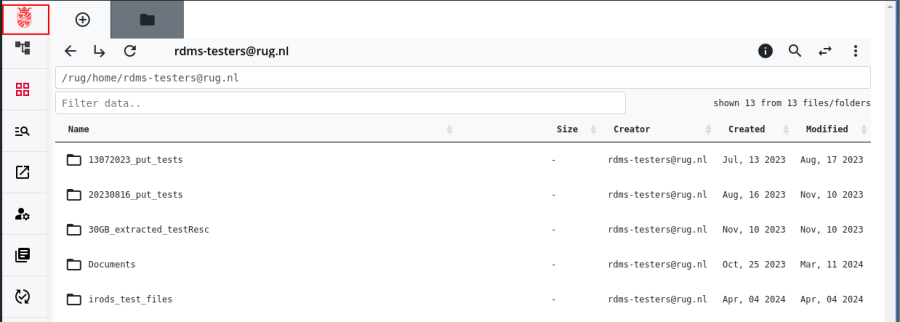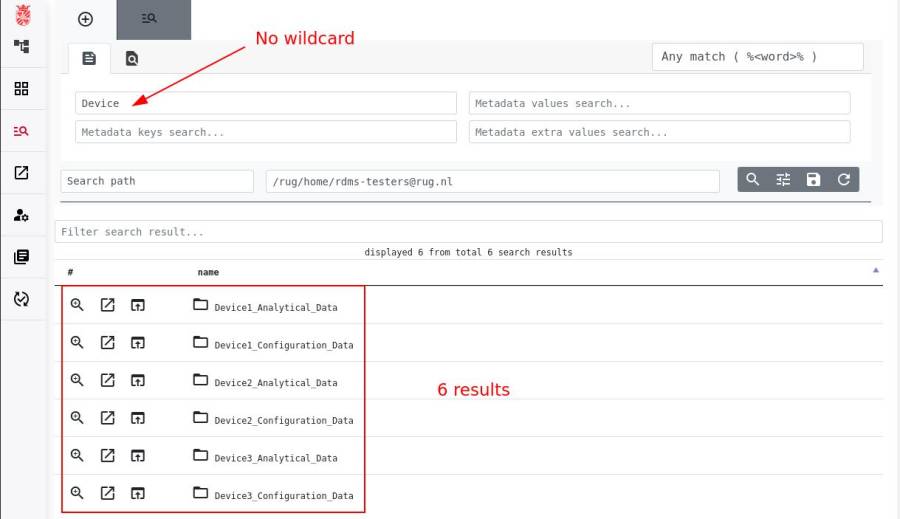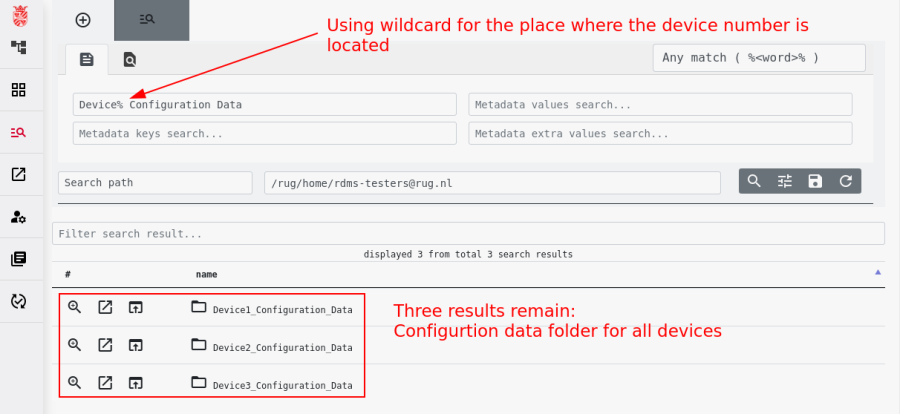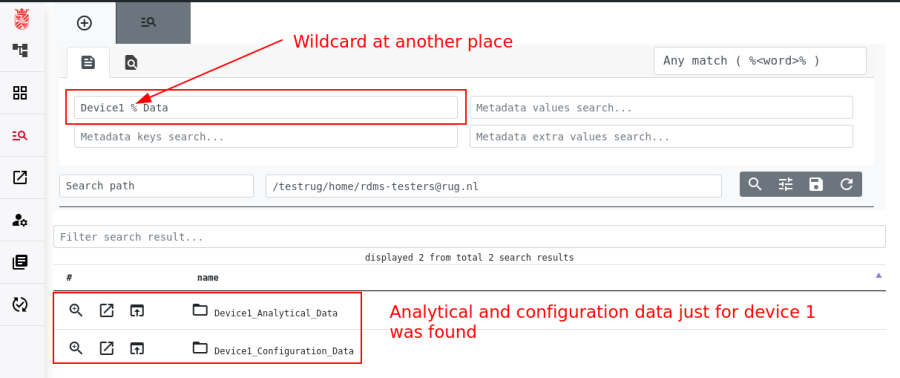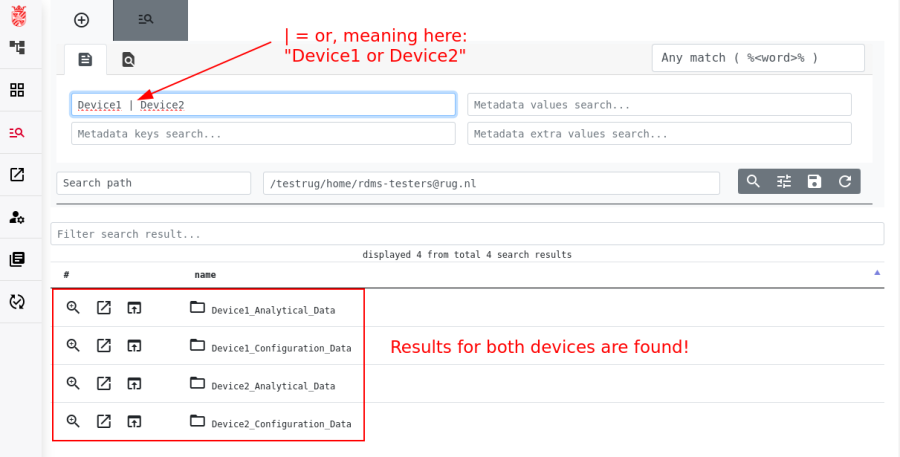Search
The RDMS web interface comes with an extensive and flexible search functionality. Unlike other UG storage solutions, this search engine offers the advantage of utilizing metadata for exact data queries. Additionally, the integrated search engine also allows you to make more elaborate queries or searches, such as combining multiple metadata entries.
The next subsections will explain the basic functions of the integrated search and provide some more elaborate search and query examples using metadata.
Accessing RDMS Search
You can access the search engine via the left-side Menu bar in the web interface.
After logging into the interface, click the ![]() button to open the search function in the current window (see screenshot below).
button to open the search function in the current window (see screenshot below).
General Functionality
General vs. Key-Value-Extra Search
The search functionality in the RDMS is available in two distinct options:
- General search: This option allows you to find data based on various criteria. It uses both, system-defined metadata and metadata added by the user, to search the system for files and folders fitting the desired parameters.
- Key-Value-Extra (KVE) search: This search option is specifically designed for querying using multiple metadata entries simultaneously. You can access this search option via the
 button at the top of the search interface.
button at the top of the search interface.
You can switch between these search options by selecting the respective tab at the top of the search interface. Further below on this page, you will find more examples demonstrating how to utilize these search options for both simple and more complex queries in the RDMS.
Tabbed Searches
If you wish to perform and manage multiple search queries simultaneously, the top menu in the search interface allows you to add new search tabs via the ![]() button.
button.
Saved Searches
Another function available to you is to save searches for future use. To save a search, click the ![]() button in the search view after you have specified your desired search terms.
button in the search view after you have specified your desired search terms.
The system will then ask you to name the search you are saving. We suggest you choose a meaningful and descriptive name for the search, so as to be able to recall what the search was meant to do when reloading it later on.
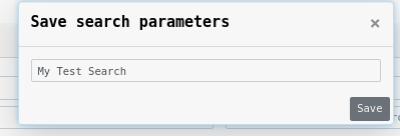
If you want to reload a saved search, simply look to the browser menu in the search window. All your saved searches are visible there, as shown in the screenshot below. Clicking on the name of a saved search will load the parameters into the search window of the RDMS. Click on the ![]() icon in the search window to initiate the search. If you want to remove a saved search, click instead on the
icon in the search window to initiate the search. If you want to remove a saved search, click instead on the ![]() icon.
icon.
Sub-Searches
Whenever a search finds at least one object, the RDMS allows you to execute subsequent searches based on the search result that was found. To access this feature, click on the icon highlighted in red in the screenshot below. The RDMS will then open a new search tab with the search parameters of the previous query already defined. Click on the ![]() icon to initiate the search inside the new location.
icon to initiate the search inside the new location.
Notes:
- If you want to perform a sub-search on a folder, then the RDMS will repeat the search inside the folder you selected.
- If instead you select a file for the sub-search, then the RDMS will perform the search inside the folder containing said file.
- Inside the sub-search tab, you can use either the general search or the KVE search.
- If needed, you can also do sub-searches of sub-searches. The process is simply repeated for the new location.
Opening Search Results
Once you have performed a query, the RDMS search window allows you to open the location of specific search results in two different ways:
 button: This button opens the result in a new data browser tab. This will keep the initial search active in the parent tab, should you want to go back to it.
button: This button opens the result in a new data browser tab. This will keep the initial search active in the parent tab, should you want to go back to it. button: This button opens the result in the current tab. This replaces the search window with the Data Browser open in the location of the data you found. If you want to return to the search, you will have to navigate back to the search window from the left-side Menu and perform the search again.
button: This button opens the result in the current tab. This replaces the search window with the Data Browser open in the location of the data you found. If you want to return to the search, you will have to navigate back to the search window from the left-side Menu and perform the search again.
Using RDMS Search
General Search
To perform the most basic form of searching for data, you can specify the search term in the top box in the search engine and then execute the search by clicking on the ![]() icon (see screenshot).
icon (see screenshot).
This simple method of searching looks for the specified term in the name of any files and folders.
If you want to target a specific metadata entry in your search, you can adjust the search criteria by searching for a specific metadata value, key, or extra value. You can modify the path where the search needs to be performed, and you can also indicate whether you want to search for files and folders, or only for one of the two. Other options as to what you can adjust in the search are visible in the screenshot above and explained in the text below.
In the screenshot above, you can see the three different areas where you can specify the search criteria in the main search view:
- Blue Box: Here you can specify the path of the location you want to search in. The default value here is
/rug/home/, but you can adjust it either manually or by performing a sub-search as described above. There are also several pre-defined values possible (e.g., “My home” or “All”). - Red Box: Here you can specify more details about the search mode. For example, you can say if you want to see files or folders, if you want to find just data created in a certain time frame, or if your search should be case sensitive or not. If you do not see this menu, you can reveal it by clicking the
 button. By default, all parameters are considered to have to be valid at the same time for an object to be considered a valid search result (logical argument is
button. By default, all parameters are considered to have to be valid at the same time for an object to be considered a valid search result (logical argument is AND, look to the left inside the box). If you want to find objects that do not need to fulfill all the search criteria simultaneously, please change the relevant values toOR. - Green Box: This additional box allows for further fine-tuning of the search method. In this field, you select how the entered search term(s) should be interpreted.
Any match (%<word>%)will find the search term either alone or contained in another term (e.g., searching for “time” would also be positive for “timecapsule” or “walltime”).Exact match, on the other hand, just gives a positive search result if the exact search term(s) were found. The two other selection criteria,Right truncated (<word>%)andLeft truncated (%<word>), are positive if the search term was found either at the start or end of a value, respectively.
Note: The % sign in the green box explanation is the wildcard sign for the RDMS search. Its meaning is that whatever is not contained by two % signs or does precede or follow it, does not matter. Example: “%cube” would find all entries that are either the exact word “cube” or that end in the word “cube”, no matter with what other term they start. Please keep in mind that the position of the % sign matters when performing a search.
Key/Value/Extra Search (Combined Metdata)
While the general search window can also be used to search based on metadata, the separate Key/Value/Extra (KVE) search was specifically designed to facilitate queries that use multiple, combined metadata values as the search criteria.
To perform a KVE search, first access the KVE tab (![]() ) from the top of the search view. You will see that the KVE search contains search fields for metadata keys (K), metadata values (V), and metadata extra values (E), while the “File/folder name…” option that was available in the general search is not available here.
) from the top of the search view. You will see that the KVE search contains search fields for metadata keys (K), metadata values (V), and metadata extra values (E), while the “File/folder name…” option that was available in the general search is not available here.
Instead of being able to search for only one term for each field, the KVE search allows you to add new KVE lines by selecting the ![]() button. If you want to remove a KVE line that you added, you can use the
button. If you want to remove a KVE line that you added, you can use the ![]() button to do so.
button to do so.
We will use the example below to explain the correct usage of this functionality. Let us start with the search shown in the screenshot below:
In this example, we used a single KVE line as search criteria (Key: “Author”, Value: “John Doe”), which resulted in four files being found by the search. While four files are easy to sort through to find the correct file we want, let's consider that instead the search returned a number of files in the thousands. Because those would be too many files to sort through, we attempt to filter the results by adding a new KVE line. So we press the ![]() and add a new KVE line with the search terms:
and add a new KVE line with the search terms: Key: “Date”, Value: “today”.
Instead of seeing the four results as before, we now just get two of the previous results shown. This is because only two files contained the combination of Author: John Doe and Date: today in their metadata. As a result, the other files are removed from being listed in the second search.
But let's assume that our attempt at filtering has failed and that we still have too many files to sort through. We decide to introduce a third KVE line with the terms Key: “Distance”, Value: “10”, Extra value: “m”, which results in finally having only one result in the search list.
This example is used to properly showcase how to use all the fields in a KVE line and how multiple KVE lines can limit the amount of results you obtain in a given search. Of course, you can use the line and fields however you see most fit to isolate the search results you need.
Notes:
- The function of combining multiple KVE entries to narrow down search results makes the metadata-based search of the RDMS web interface very powerful. This function is especially helpful for cases where there is a lot of data with distinct, but similar metadata entries.
- If you are unsure about what KVE combination is correct for any given line, only input the values that you are sure of. Example: If you search for
Key: “Author”, Value: “John Doe”, but a file hasCreator: John Doein its metadata, said file will not be found with the given search parameters. You will find the file, however, if you simply search forValue: “John Doe”.
Further Tips
Using Fast Search
In addition to the search function explained so far, the RDMS also has a fast search that can be used to make simple searches from any location in the RDMS.
To access the fast search, simply click on the UG logo in the top-left corner of the web interface:
A menu will reveal two fields where you can perform your search. The field on the left allows you to search for a specific RDMS path and open it directly in the browser; the field on the right will instead perform a search of a given term with all the default parameters and open the search window with the results.
Note: Please consider that the fast search will perform an “Exact Match” search for a term and look for the term in all four fields of the general search window. This function has been developed mainly for users with a long file list to check, who would otherwise have to wait for an unreasonably long time for the search results to appear. The fast search is thus not a “fast access to the search function”, but rather a “search performed fast”. If you do not have long waiting times when performing searches, it is better to navigate to the search window and perform a search as described in the previous sections to obtain more meaningful results.
More Advanced Search Syntax
In previous sections, we already anticipated some of the special characters that you can use in the input fields to signal to the RDMS that you want to perform a special operation during the search. When you specify a search term in the field, it is important to know that you can also use additional wildcard characters in your query. These wildcard characters are:
_: The underscore is the wildcard for one character. Searching for “Device_-Data” will find results for “DeviceA-Data”, “DeviceB-Data”, “DeviceC-Data”, and so on, but not for “DeviceXXX-Data”, as the characters after the term “Device” are three and not one.%: The percentage sign is the wildcard for an undefined number of characters. Searching for “Device%-Data” will find the same results as described for “Device_-Data”, but additionally also “DeviceXXX-Data”, as it does not matter how many characters follow the term “Device”.
Note that these wildcard characters are recognized within the RDMS, no matter which field you use to search for a term. To see how you can use these wildcards for further filtering of your query, take a look at this example, where we first searched for “Device”. This search yielded six similarly named folders, each with slight variations:
Let us assume that we do not care about the analytical data, but want to find the configuration data for all 3 devices. We can see in our search results that all configuration data folders are called the same way, except for the number of the device. Since only one value differs, we could search for “Device_ Configuration Data” and get all three folders that we need. A more general option, especially if you have more than a single character changing between files or folders, is “Device% Configuration Data”.
As we used the % wildcard character in this example, this would also find results like “Device312_Configuration_Data” or “DeviceBuilding4_Configuration_Data”, if they existed.
In another example, suppose we want to find both the analytical and configuration data folders for “Device1”, but we do not want results for the other devices. We can achieve this with a query of the form “Device1_%_Data” (or even more simply “Device1%”), as seen here:
In addition to the wildcard characters, it is also possible to use & and | in the search, which act as “and” and “or” operators, respectively.
Let's assume that you want to find results that contain either “Device1” or “Device2” in their name. You can create a search query for this “or” statement by writing “Device1 | Device2”, which will yield:
Note: As seen above, you can use wildcards to further fine-tune your search results. With other settings that are available in the search interface, together with the possibility to use metadata, these advanced search techniques offer a lot of capability to obtain precise results tailored to your specific requirements.
Filtering Your Search Results
In some cases, your search parameters might return a pool of results that is too large to find what you are looking for. The figure below shows you that the RDMS Web interface also warns you when the number of results exceeds 10.000.
To fix this, you might want to redefine your search parameters, as the Web interface suggests. However, this can sometimes result in having to wait a long time for a search to run again. As an alternative, the RDMS allows you to filter the results you have already obtained by typing in an additional keyword in the bar highlighted by the red box in the figure below.
With the new keyword added, the RDMS Web interface will show you only the results that contain the keyword. Thus, you can reduce the number of displayed results without running a new search. The figure below shows what the filtering looks like.
Note: What we have shown here is used to filter the search results. You are not redefining the original search parameters. This means that should you save the search and run it again, you will need to type in the filter manually again. And this will be true each time you run that specific search. We recommend that, for frequently performed searches, instead of doing this, you redefine the parameters once you have identified the optimal keyword combination through filtering.
Exporting Search Results (Report Generation)
The RDMS also comes with built-in functionality to export search results in formats suitable for a report. To access this feature, first execute your search. Once the search results are displayed, you can select one of the available report functions:
- Create report: This function creates a set of JSON files containing the search results. From these files, you can then create the final report.
- Export search results as…: This function directly exports the search results in a presentable format that you can choose (currently *.csv)
Using the Create Report Function
If you select “Create report”, a dialog window will open. Here, you can specify a name for your report and select if you want to encrypt the JSON file created as an intermediate step. A reason to encrypt the JSON file would be, for example, if your search parameters or the metadata of your results contain sensitive information. Since the JSON file contains and displays both, you might want to choose to encrypt it to protect potentially sensitive information.
After you confirm your choices, your report will be visible if you click the report button (![]() ) in the left-hand Menu bar. Please keep in mind that, depending on your screen resolution, this button might be hidden. If you do not see it, then press the
) in the left-hand Menu bar. Please keep in mind that, depending on your screen resolution, this button might be hidden. If you do not see it, then press the ![]() button to reveal all hidden Menu items.
button to reveal all hidden Menu items.
From within the report window, you can now manage reports you have saved. You can choose to either create your final report in CSV format, view or download the JSON files containing your search results and parameters, or delete one or more reports (see screenshot below).
If you select the option to create your final report for export, a new window will open. The first option in that window will ask you for the location to save your report file. This will be an RDMS location where you will be able to retrieve the final report by downloading it from the web interface (the file size should be small enough to allow this). The options below in the same window ask you to select which part of the results you want to include in the report (data, metadata, and/or permissions), in what format you want the report, and what metadata to include.
After you give confirmation, the RDMS will save the report in the specified location, and you can download it in CSV format from the web interface.
Notes:
- While it is not mandatory to select encryption for the created JSON files with your search results and parameters, we advise you to do so if the exported results contain sensitive data. Having encryption selected is also recommended as simply good practice.
- The report will contain system-defined metadata added by default (“Data type”, “Size”, “Creator”, “Modified”), even if you did not add any user-defined metadata.
Using the "Export Search Results as" Function
The “Export search results as…” function allows you to directly create an exportable CSV from your search results. If you select this option from the search view, you will be asked where your exportable CSV should be saved within the RDMS. Afterwards, you are asked to select the export type (data, metadata, and/or permissions), and to specify a name for your export (a default value is automatically filled in).
Clicking on “Export report” will generate a CSV file in the specified location. You can retrieve the report by navigating to the specified RDMS location and downloading the report from the web interface.
Notes:
- The “Export search results as…” function is a shortcut way to generate an exportable CSV of your search results, and as such, it does not allow you to directly select which metadata to extract, if metadata is included in your report. Instead, all metadata is exported by default.
- Choosing the “Export search results as…” function will still create a JSON file in the background. These files contain your search results and parameters. You can access them via the report button (
 ) in the left Menu bar. By doing so, you can create further reports from these intermediate JSON files, and you can fine-tune the export parameters (e.g., which metadata to include in the CSV).
) in the left Menu bar. By doing so, you can create further reports from these intermediate JSON files, and you can fine-tune the export parameters (e.g., which metadata to include in the CSV). - The “Export search results as…” will automatically use encryption for the intermediate JSON files that are created.
Importing Report Files in Spreadsheet Tools
The CSV reports you download from the RDMS can be imported into spreadsheet tools (e.g., MS Excel, LibreOffice) for visualization and further processing. It is important to note that the CSV reports in the RDMS use tab as field delimiter! Please be sure that you select this during import in your spreadsheet tool, as it will otherwise break the formatting of your import, and the data will be hard to read.
Another important aspect to consider is that the RDMS metadata fields can be multi-line fields. In cases where this causes problems when importing the CSV into another tool, you can choose to automatically replace newlines in the exported CSV by simply selecting a replacement character during report creation (see screenshot below).












